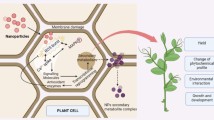Abstract
We investigated the effect of elicitation on cell wall strengthening in eggplant roots caused by 6 elicitors viz., chitosan (CH), salicylic acid (SA), methyl jasmonate, methyl salicylate and vitamins B2 and B12. Analysis of phenolic metabolites from eggplant roots by HPLC revealed presence of 6 major cell wall-bound phenolic compounds. They were 4-hydroxybenzoic acid (4-HBA), vanillic acid (VA), 4-hydroxybenzaldehyde (4-HBAld), vanillin (VAN), 4-coumaric acid (4-CA) and ferulic acid (FA). In eggplant roots, the concentrations of FA, VA and 4-HBA were 188.71, 113.64 and 109.42 μg/g DW, respectively, and they were higher than those of 4-HBAld, VAN and 4-CA. When elicited roots were analyzed by HPLC, quantitative differences could be clearly discerned in the amount of the phenolic compounds. After 48 h post-elicitation (hpe) in the presence of CH, the increase in 4-HBA, 4-CA and FA contents in cell wall was 2.6-, 2.8- and 3.0-fold, respectively, compared with control. After 72 hpe, in the presence of SA, the increase in 4-HBA, 4-CA and FA levels was 3.5-, 2.9- and 3.8-fold, respectively, compared with the control. As the elicitors have specific receptors in plants, it may be possible to utilize CH and SA for inducing resistance against important diseases in eggplant.
Similar content being viewed by others
References
Thordal–Christensen, H., Curr. Opin. Plant Biol., 2003, vol. 6, no. 4, pp. 351–357.
Chisholm, S., Coaker, G., Day, B., and Staskawicz, B., Cell, 2006, vol. 124, no. 4, pp. 803–814.
Niemann, G.H., van der Kerk, A., Niessen, M.A., and Versluis, K., Physiol. Mol. Plant Pathol., 1991, vol. 38, no. 6, pp. 417–432.
Montesano, M., Brader, G., and Palva, E.T., Mol. Plant Pathol., 2003, vol. 4, no. 1, pp. 73–79.
Dardick, C. and Ronald, P., PLoS Pathog., 2006, vol. 2, no. 1, p. e2.
Dixon, R.A. and Lamb, C.J., Annu. Rev. Plant Physiol. Plant Mol. Biol., 1990, vol. 41, pp. 339–367.
Zhao, J., Davis, L.C., and Verpoorte, R., Biotechnol. Adv., 2005, vol. 23, no. 4, pp. 283–333.
Greenberg, J. and Yao, N., Cell Microbiol., 2004, vol. 6, no. 3, pp. 201–211.
Strange, R.N. and Scott, P.R., Annu. Rev. Phytopathol., 2005, vol. 43, pp. 83–116.
Mandal, S., Mitra, A., and Mallick, N., Plant Physiol. Biochem., 2009, vol. 47, no. 7, pp. 642–649.
Parr, A.J., Waldron, K.W., Ng, A., and Parker, M.L., J. Sc. Food Agric., 1996, vol. 71, no. 4, pp. 501–507.
Villegus, M. and Brodelius, P.E., Physiol. Plant., 1990, vol. 78, no. 3, pp. 414–420.
Mandal, S. and Mitra, A., Physiol. Mol. Plant Pathol., 2007, vol. 71, no. 4–6, pp. 201–209.
Mandal, S. and Mitra, A., Biotechnol. Lett., 2008, vol. 30, no. 7, pp. 1253–1258.
El Modafar, C., Tantaoui, A., and El Boustani, E., J. Phytopathol., 2000, vol. 148, nos. 7–8, pp. 405–411.
McKeehen, J.D., Busch, R.H., and Fulcher, R.G., J. Agric. Food Chem., 1999, vol. 47, no. 4, pp. 1476–1482.
Lewis, N.G. and Yamamoto, E., Ann. Rev. Plant Physiol. Plant Mol. Biol., 1990, vol., 41, pp. 455–496.
Vance, C.P., Kirk, T.K., and Sherwood, R.T., Ann. Rev. Phytopathol., 1980, vol. 18, pp. 259–288.
Matern, U. and Kneusel, R.E., Phytoparasitica, 1988, vol. 16, no. 2, pp. 153–170.
Fry, S.C., Annu. Rev. Plant Physiol., 1986, vol. 37, pp. 165–786.
Boller, T., Annu. Rev. Plant Physiol. Plant Mol. Biol., 1995, vol. 46, pp. 189–214.
De Ascensao, A.R.C.F. and Dubery, I.A. Phytochemistry, 2003, vol. 63, no. 6, pp. 679–686.
Campbell, M.M. and Ellis, B.E., Phytochemistry, 1992, vol. 31, no. 3, pp. 737–742.
Mandal, S., Afr. J. Biotechnol., 2010, vol. 9, no. 47, pp. 8038–8047.
Iriti, M. and Faoro, F., Plant Sig. Behav., 2009, vol. 4, no. 1, pp. 66–68.
Taheri, P. and Tarighi, S., J. Plant Physiol., 2011, vol. 168, no. 3, pp. 1114–1122.
Author information
Authors and Affiliations
Corresponding author
Additional information
The article is published in the original.
Rights and permissions
About this article
Cite this article
Mandal, S., Gupta, C.K. Inducing cell wall-bound phenolic compounds by elicitors in eggplant (Solanum melongena). Appl Biochem Microbiol 52, 650–656 (2016). https://doi.org/10.1134/S0003683816060120
Received:
Published:
Issue Date:
DOI: https://doi.org/10.1134/S0003683816060120




